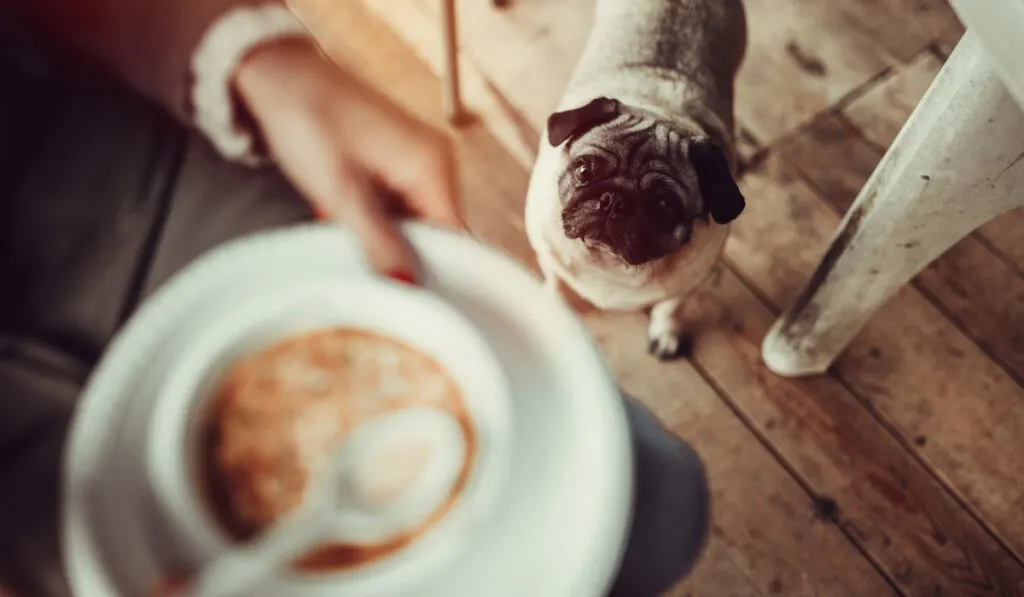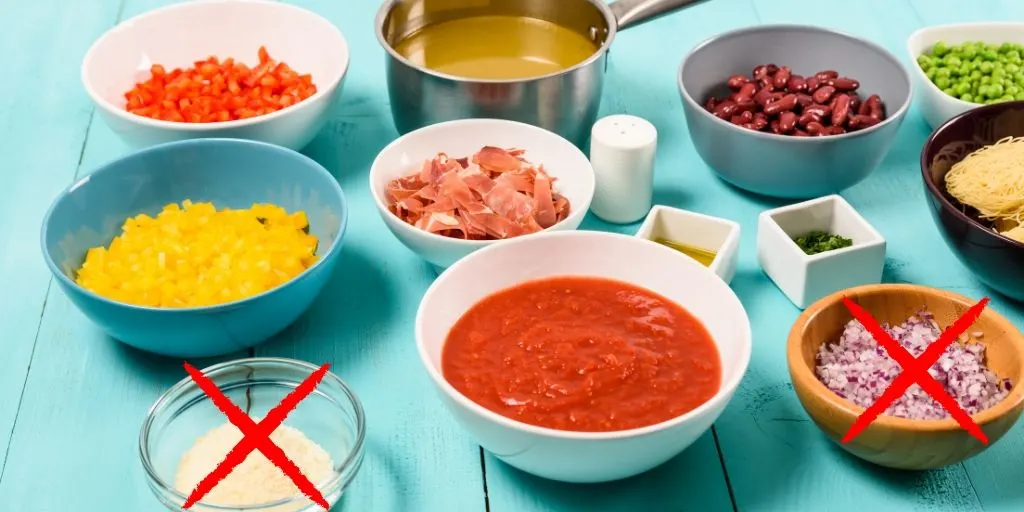Dogs are a pretty common sight in many households around the world. They’re part of the family. They even have their own specially formulated foods, but there’s always a few table scraps that make their way to the bowl of man’s best friend. Not all human food is safe for dogs, though.
Can dogs have tomato soup? The answer is, generally, no. While dogs can eat small amounts of ripe tomatoes, most tomato soups have non-dog friendly ingredients like onion and garlic in them. Onions and garlic contain a chemical that damages a dog’s red blood cells causing anemia.

Don’t scratch tomato soup off the menu just yet, though. While most store-bought soups and online recipes contain less than dog-friendly ingredients, it’s still possible to make a version of tomato soup that is safe for your dog.
Just a few modifications to any basic recipe can make a delicious soup for your dog to enjoy.
Table of Contents
Easy Ideas For Dog Safe Soups.
There’s nothing wrong with giving your pet a special treat, and soup is a great idea if you want help warm them up on a cold day.
New foods can sometimes upset dogs’ stomachs if they eat too much, so only give your dog a small serving of soup to start and see how they handle it.
Tomato Soup
Take tomatoes, pumpkin puree, and a dog-friendly chicken broth and simmer them together in a pot. It might sound like a strange combination, but pumpkin has tons of healthy fiber your dog needs.
Chicken Noodle Soup
A simple stock made from boiled chicken, carrots, and celery (without the leaves) combined with almost any store-bought noodles is a perfect treat for your furry friend on a cold day.
Vegetable Soup
Dogs are natural omnivores, and many enjoy vegetables as a healthy snack. Combine any combination of dog-friendly veggies in a pot and simmer until soft.
Peanut Soup
Peanut soup may sound strange to some people, but it’s a real thing and can be easily adjusted to be a dog-safe treat. Just combine unsalted peanut butter, dog-friendly vegetable stock, collard greens, and ripe tomato in a pot. Let it simmer for a bit and serve with brown rice if desired.
Beef Stew
Simply place stew beef cubes, carrots, celery, water, and chopped tomato to a crockpot and allow it to simmer until the meat is falling apart tender.
Is Soup Good For Dogs?
Aside from being a tasty treat, soup can also be great medicine. Dogs can get sick, just like people. This can make them lose their appetite or make it harder for them to digest their regular food.
Feeding your dog soup encourages them to eat and to drink more liquids.
There are several times where a hot bowl of soup may be beneficial to your pet.
One reason to give your dog soup is if they’re having digestive issues like diarrhea. The soup is easy to digest and helps to prevent them from becoming dehydrated.
Another reason is if the dog is having issues with their teeth. If a dog is having dental problems, it may have trouble eating hard kibble. A warm bowl of soup is a great way to help them get calories while the issue with their teeth is being addressed.
Dog-Friendly Soup Ingredients.
There are a lot of fresh produce items that can offer your dog nutrients and health benefits. These ingredients would be very nice in a dog-friendly soup.
Ripe Tomatoes. Ripe tomatoes are good ingredients to use when cooking for your dog. People sometimes disagree about the safety of tomatoes, but as long as it’s ripe and no leaves or stems make it into what you’re cooking, they’re perfectly safe.
Pumpkin. Pumpkin is full of fiber and vitamins your dog needs to stay healthy, and dogs seem to enjoy the taste.
Celery. Celery also has tons of fiber to keep your dog’s digestive system healthy, and it keeps the breath fresh.
Carrots. Carrots are a great source of vitamin A for dogs, and they go great in soup.
Peas. All types of peas are perfectly safe for dogs to eat. They have a subtle sweetness and lots of vitamins for your dog to enjoy.
Cucumbers. Cucumbers are an excellent treat for dogs. They contain very few carbohydrates, oils, or fats and a lot of vitamins and minerals. Cucumbers can even increase your dog’s energy level.

Ingredients To Avoid When Cooking For Your Dog.
Just as there are foods that are good for dogs, there are also foods that are bad for dogs. These are ingredients that should never be used when making soup for your dog.
Salt. Salt may taste good to humans, but to dogs, it can be dangerous—dogs who ingest too much salt risk kidney vomiting, diarrhea, or even kidney damage.
Onions. Onions may be one of the most popular vegetables amongst humans, but they can be quite toxic to dogs. Chemicals in onions, chives, and leeks can cause a dog’s red blood cells to rupture.
Garlic. Like onions, garlic can also cause the red blood cells in your dog’s body to rupture. They can also cause gastroenteritis, which is when the lining of their digestive system becomes inflamed.
Unripe or Green Tomatoes. Ripe, red tomatoes are safe for dogs in small amounts, but unripe tomatoes, stems, and leaves can be very dangerous for dogs to ingest.
Cooked Bones. Boiling bones is a great way to make a healthy broth to use as a base for all kinds of soup. While it may be tempting to give these bones to your dog, it’s not a great idea. Cooked bones can splinter and cause damage to your dog’s throat and stomach.
Avocado. Avocados are very dangerous for dogs. The skin, pit, and flesh all contain a chemical known to cause vomiting and diarrhea in dogs and should be avoided at all costs.
Benefits To Cooking For Your Pet.
Cooking for your pet can be great fun and a fantastic way to bond with them. Many store-bought foods use ingredients that may actually be harmful to dogs. Cooking their food at home allows you to know exactly what’s going into your pets’ food.
Cooking at home is especially useful when you have a dog with stomach sensitivities or allergies. Soup isn’t the only thing you can cook either. There are hundreds of recipes for dog food and treats online.
If you want to start cooking your dog’s food at home, you should make an appointment with your veterinarian to ensure the food you make will be well balanced and fulfill your dog’s dietary requirements.
The Downsides To Cooking For Your Pet.
Making soup for your dogs as an occasional treat is a great thing to do, but it shouldn’t be the only food your dog eats. Dogs need to consume a specific ratio of protein, fat, and carbs, all adding up to a healthy number of calories. Commercial dog food is specially formulated to fill all of your dog’s dietary needs.
It isn’t very easy to formulate the proper ratios at home. Often dogs eating homemade food have to take supplements to substitute what they aren’t getting from their diet.
If you do decide to take on the challenge of cooking your own dog food, it’s best to consult a veterinarian before you start to ensure your dog’s health.
It also takes a substantial amount of time and money to cook for your dog, and if you’re unable to devote the time every day, then it’s best to stick to store-bought dog food.
